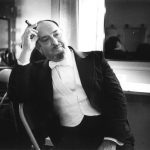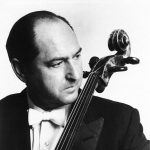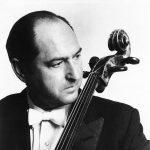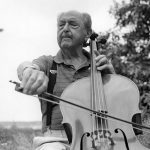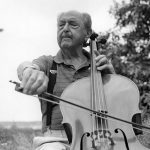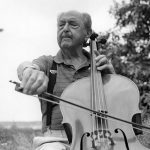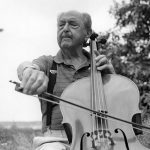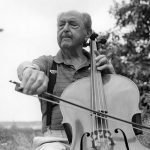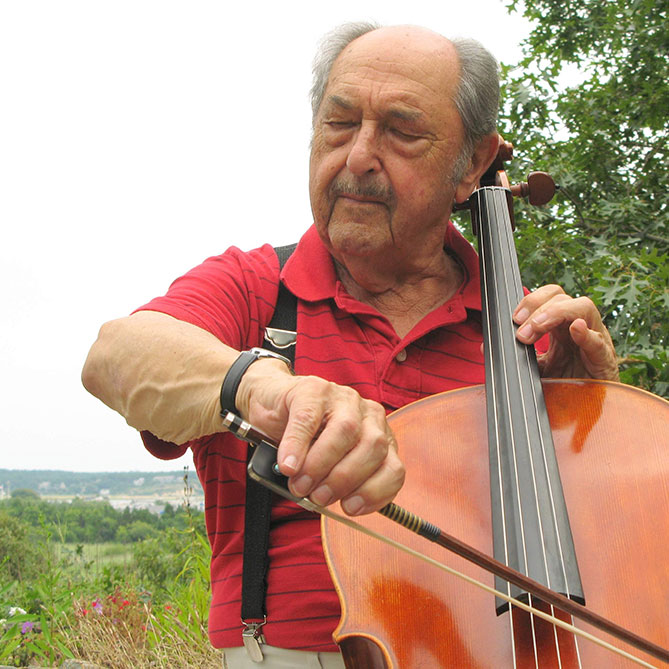
Bernard Greenhouse
Bernard Greenhouse was probably best known as one of the founding members of the Beaux Arts Trio. Greenhouse had a significant career as a solo cellist both before formation of the trio and during his 32 years of service in it. A student of Casals, Greenhouse mastered a broad cello repertory in the chamber realm, from Haydn, Mozart, Beethoven, Schubert, and Brahms to Ives, Ravel, Rachmaninov, and Shostakovich. But, especially in his freelance work, he also regularly performed contemporary works, like the Elliott Carter Sonata for cello and piano, which he premiered. Greenhouse also taught cello throughout most of his career, holding posts at various times on the faculties of the Manhattan School of Music, the New England Conservatory, Rutgers University, and Juilliard. Greenhouse appeared on more than 50 recordings over the years, both as a member of the trio and as a freelance cellist. Most are available on the Philips labels, with a few scattered on Decca, DG, Sony, Boston Records, and PentaTone.
Bernard Greenhouse was born in Newark, NJ, on January 3, 1916. He began study on the cello at nine, and later sang briefly as a boy soprano. At 18 Greenhouse enrolled at Juilliard for studies with Felix Salmond. Following graduation Greenhouse joined the CBS Radio Orchestra (1938). He would soon become principal cello, but his rapid advancement did not deter him from further studies: later teachers would include Emanuel Feuermann and, from 1946-1948, Pablo Casals.
During the war Greenhouse served in the Navy, playing cello in the orchestra and oboe in the marching band. Greenhouse joined the Bach Aria Group, a vocal/instrumental ensemble, in 1948, and would appear regularly with the group until 1977. From the late ’40s to about 1960, Greenhouse also actively pursued a solo career. In the midst of all this activity he helped found the Beaux Arts Trio in 1955 with pianist Menahem Pressler and violinist Daniel Guilet.
Greenhouse would serve as cellist in the trio until 1987. With countless acclaimed tours abroad and numerous benchmark recordings, he served in what would become arguably the finest piano trio of its time.
Following retirement from the trio Greenhouse continued his activities as a teacher. In the late ’90s he retired from both Rutgers University and the New England Conservatory. Greenhouse did continue to offer master classes, and as late as 2008, when he was 92, he was still active in that capacity
From the true affection that Mr. Greenhouse gave to each one of his students to the profound mastery of his instrument, Mr. Greenhouse was the epitome of the grand style of teaching. I remember the thoughtful manner in which Mr. Greenhouse strove to have his students understand the difficulties of our instrument, technically and musically – above all, the music – in the Socratic style of asking us to understand and to find our own answers.
– Judith Glyde, Professor of Cello, University of Colorado
The artistry of Bernard Greenhouse’s teaching has influenced generations of cellists for well over fifty years. Throughout his remarkable performance career as the founding cellist of both the Beaux Arts Trio and The Bach Aria Group, Bernard Greenhouse was equally devoted to his students. For nearly 70 years, Greenhouse taught at the Manhattan School of Music, Juilliard, New England Conservatory, the State University of New York at Stony Brook, and Rutgers University.
Bernard Greenhouse was born on January 3, 1916 in Newark, New Jersey. Greenhouse made his decision about whether to purse a career as a doctor or as a cellist when Juilliard awarded him a scholarship. Greenhouse studied at Juilliard with Felix Salmond, and following his graduation, continued lessons with Emanuel Feuerman and Diran Alexanian. His final teacher was Pablo Casals with whom he studied from 1946-1948.
Many of Greenhouse’s students recall the stories he shared with them regarding these great cellists of the past. Rolf Gjelsten describes how Greenhouse was committed to passing on the most important messages of the musical tradition he inherited from immortal musicians like Pablo Casals and Emmanuel Feuermann. He believes that “great artistry should not be lost. It should be assimilated.”
Paul Katz decided to leave California for study with Bernard Greenhouse after being mesmerized by Greenhouse performances with the Bach Aria Group and Beaux Arts Trio. The sound of Greenhouse’s playing first captivated Katz’s imagination, and Greenhouse’s teaching drew Katz into a new world of sound, color, and phrasing on the cello:
Perhaps most important of all was Greenhouse’s artistic impact on me. The warmth of his sound and the way he colored notes has influenced me over a lifetime. Today, forty years later, I like to think of myself as a colorist; I am preoccupied by what I can paint inside a single sound. For a sound to stay alive, something interesting should happen within it.
Timothy Eddy, another Greenhouse student, describes his experiences of working with Greenhouse: The most important lessons I learned from him were, first of all, to use the sounds of the cello to “speak” with the audience, passionately and candidly, searching always for beauty and clarity of expression. Secondly, he made me aware that every sound I make is saying something, whether on purpose or by accident, and that I must listen constantly and intensely to be sure I am expressing what I really mean!
Greenhouse’s sound drew his students to him. In the words of Eric Edberg, Professor of Music at Depauw University, Greenhouse’s sound is one that “enriches and reveals the music, not a sound that draws attention to itself.” Out of this glorious sound, Greenhouse’s students drew a vital lesson about their roles as performers and teachers. Eric Edberg describes how “from everything Greenhouse did and said, it was clear that his approach was always about serving the music and bringing it to life. Technique was never an end in itself.”
By Elizabeth Aureden
Read more tributes for Bernard Greenhouse on CelloBello.com.
Bernard Greenhouse emphasized harnessing the body’s natural strength as the fundamental source of expressive and healthy cello technique. Cello playing does not begin when the fingers of the left hand touch the fingerboard and as the bow sets the string in motion. Cello playing begins in the back, before the sound. The back unifies the specific tasks of the right and left hands, merging them together into efficiently integrated movements directed towards individual creative expression. While Greenhouse frequently spoke about releasing the weight of the left hand into the fingerboard and the weight of the right hand into the strings, he first asked his students to develop awareness of the source of that weight. Describing this fundamental physical connection to the cello, Greenhouse explained:
. . . arm weight is not the most important thing, it’s being able to attach the weight of the arm to the spine, since the back has an enormous influence on the ease of playing, a notion I got from Feuermann and Casals. The smaller the amount of body you use, the more difficult it is to play with strength. When the back is more involved, you achieve a feeling of freedom and power that you cannot attain when you play only with your arms, hands, and fingers. The motion should start from the back, not from the arm or shoulder. When you put your finger down, for instance, it’s not the finger that is creating the strength, it’s your back that’s pulling the finger down. You should use the large muscles of your body in order to create the ease and strength. [Internet Cello Society]
Left Hand
- ARM WEIGHT – Relying upon left arm weight as source of power provides an ease of motion extending into the hand and fingers. This weight maximizes the capacity of the fingers to sink into the fingerboard; the fingers move easily, but also with intention. Greenhouse credits Feuermann with showing him “the technique of getting around the instrument with minimal effort, taking advantage of arm weight when fingering.”
- EASE OF MOTION – The fingers of a supple and relaxed left hand rely upon the weight of the left arm to sink into the fingerboard. The arm weight hangs on the playing finger, enabling it to sink into the fingerboard; the weight of the arm is then turned into the new playing finger and the old playing finger releases and becomes soft. While the weight of the arm is concentrated into the playing finger, the other fingers remain supple. These non-playing fingers must be relaxed in order to maintain a facile left hand poised to move across the surface of the fingerboard. Prolonged use of extended positions interferes with a relaxed left hand. Greenhouse passed along to his students Feuermann’s wisdom, recalling that Feuermann “discussed and demonstrated the technique of the left hand in a completely new way, minimizing the use of extensions.”
- SHIFTS – Anticipate and prepare shifts. When a passage calls for a series of quick, frequent shifts such as 1-2, 1-2, 1-2-3 in a scale, practice connecting them and feeling them as one continuous fluid motion. Recalling the ways that this technique influenced his own playing, Paul Katz explains, “it all has to do with anticipating the required motion instead of doing a bunch of quick stops and starts. Anticipating means beginning the motion earlier which results in a slower shift, rather than a quick, jammed motion. A series of shifts close together can be felt as one continuous motion. Greenhouse gave me a fluidity that I didn’t have before.”
- ARTICULATION – During his studies with Casals, Greenhouse was introduced to the role of left hand articulation in creating phrase shapes and colors. Greenhouse recalled that Casals “insisted that every note have a definite beginning, even if it was to be played pianissimo. A consonant is heard when the finger audibly comes down on the instrument, when you want the note to have a sharp beginning. A vowel is played when the finger is placed less percussively, giving the note a milder beginning. In other words, a consonant is more articulated.”
- VIBRATO – There are multiple varieties of vibrato motion defined by its width, its speed, and whether the motion is initiated in the arm, the wrist, or the finger. A cellist’s choice of vibrato is influenced by reflecting upon the expressive demands of the music, the string being played on and the location of the hand on the fingerboard.
Right Hand
- ARM WEIGHT – From Casals, Greenhouse integrated the technique of releasing arm weight in his right arm as well as his left arm, unifying the feeling of both halves of the body.
- TONAL COLORS – Teaching students ways to imagine and then create distinct sounds and colors was a defining quality of Greenhouse’s message to them. Greenhouse constantly challenged his students to attend to their choices regarding bow speed, contact point, and weight in the string. The choices of how to combine these three variables are as endless as the ways in which each performer crafts their own interpretations.
Interpretation
Ultimately, the two hands work together in unison expressing the ideas of both composer and the performer. Greenhouse reminded his students that the two hands never work separately. Rather, the two hands respond to and support each other through the process of crafting an intelligent, personal, and compelling performance.
- PHRASING – A cornerstone of the ways in which Greenhouse drew his students out as independent interpreters grew out of Casals concept of the phrase as an “arch.” Greenhouse recalled Casals describing how “each phrase has a beginning, reaches the top in a beautiful arching way, and then comes down to the starting point. Casals called these “rainbows.”
- ARCHITECTURE – Creating an expressive performance requires thinking about not only the unique shape of each individual phrase, but also about the relationship of phrases. Casals regularly used the metaphor of the cellist as “architect” to convey the necessity of considering the details of each phrase within the larger structure of a piece of music.
- EXPRESSION – Fundamental to Greenhouse was the ideal that the performer’s role is to take the audience on their own musical journey. Excessive movement or displays of emotion from the performer draw attention to the performer rather than the sounds that they are creating.
Excerpted from Tim Janof’s Internet Cello Society interview with Bernard Greenhouse
Tribute to Bernard Greenhouse On the Occasion of Greenhouse’s 90 Birthday Celebration
By Paul Katz
Some of us that studied with Bernie are now at an age where, let’s face it, some important memories have begun to fade– I know what I am talking about. Therefore, it is all the more incredible how vividly I remember the magic of Bernard Greenhouse’s sound the first time I heard him (with The Bach Aria Group), in Pasadena, California, in 1961. The elegance, imagination, and perfection of his playing that night was an inspiration that has always stayed with me. Three months later I nearly had to kill to get tickets for The Beaux Arts Trio, but, like an addict still high from the first experience, I just had to hear that sound again. The Beaux Arts played the Dvorak “Dumky” and the Beethoven “Archduke” Trios that night (which is why I proposed them to Brooks Whitehouse when he asked me what I would like to play for our current celebration). The Beaux Arts and their cellist enthralled me. While listening to Bernie play, I made the decision that I must study with him, and the following September I arrived in New York to begin lessons with him.
For two inspiring years Bernie worked with me: “First, I am going to fix your left hand- hang your arm on the playing finger, roll the weight from the old to the new finger, soften the hand, prepare your shifts, align your fingers from the top to the bottom of the cello…” My facility and accuracy made giant strides. At the same time, he opened a whole new world of color for me: “Vary your bow speed and contact point, paint with your bow; modulate your vibrato to fit the dynamic and the character; experiment with fingerings, they are an important expressive tool! Don’t sing here- speak – don’t speak here -sing.” On and on, and the frustration I had always suffered from, of feeling something inside of myself but not being able to bring it out of the cello, began to lessen. Bernie’s warmth, devotion and interest in all of his students was remarkable-he was both stern taskmaster and friend. In the summer of 1963, after a punishing season of touring, he finally got a few free weeks at his home in Wellfleet. Of course, always the involved teacher, he invited this California boy for two weeks of daily lessons, yachting and clam digging on Cape Cod. (I have become even more amazed by this generosity as the years have passed, for I also adore teaching and am close to my students, but I have never ever had the energy or devotion to take them with me on holiday!)
Years went by, the Cleveland Quartet and teaching at the Eastman School became the center of my musical life, and the warmth and humanity expressed in Bernie’s sound and his words of cello advice always stayed with me. What a thrill when we began to play concerts together! Of the numerous Schubert Quintet performances we did together, one of the most memorable was at the New York Metropolitan Museum of Art at a time that the Cleveland Quartet was playing on The Paganini Strads, a quartet of instruments that had been matched, owned and played on by Paganini himself. Bernie’s own glorious Stradivari cello has, of course the same nickname of “Paganini,” and he explained to us that his cello had been the original instrument in the quartet. For some reason, the maestro sold Bernie’s instrument and replaced it with the one I was using (in my opinion, a mistake, unless, perhaps, Paganini’s idea of quartet playing was to dominate!) We all had goose bumps that night when all 5 instruments were reunited on stage, and of course, I got the additional thrill of playing with my teacher.
On a more poignant note, I will never forget a recording session of the Brahms Sextets with the Cleveland Quartet, Pinchas Zukerman and Bernard Greenhouse in the late 1970’s (here’s an example of my failing memory-I’m not at all sure of the year.) At the end of a grueling day, Bernie and I left the RCA studios and started up 6th Avenue together. Bernie was barely moving and it quickly became apparent that he was unable to walk and carry his cello. He told me it was nothing at all, “a little angina,” but his labored gasps for air told me otherwise. I carried both instruments, helped him into a taxi, and fought back tears, for I was concerned that he might have little time left.
What could be more amazing and splendid then, to be here with him almost 30 years later, in the year 2005, celebrating Bernard Greenhouse’s 90th birthday!!! Congratulations Bernie!! Bravo for a lifetime of inspired music making and teaching; the adoration and gratitude of generations of those of us behind you has been so well earned and so richly deserved!
The sound of the cello can work miracles: the sound of the cello can make people cry or fall in love, and the sound of Bernard Greenhouse has changed my life!
History
Bernard Greenhouse Describes Lessons with Casals
Despite Casals' assertion that he has no time to teach, Greenhouse remains undeterred.
Bernard Greenhouse Recounts Pursuing Pablo Casals
Lessons in Prades, France. Bernard Greenhouse in conversation with Paul Katz, 2008.
